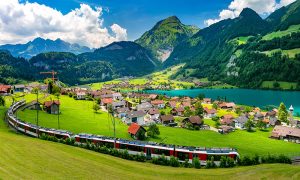With the globalimmigrantstrends, New Zealand continues to be a popular immigration destination due to its stable economy, beautiful natural environment and high quality of life.2025.New Zealand immigration policyThere are a number of adjustments, particularly inskilled migrantThe following are some examples of the types of work visas, work visas andinvestment immigrationaspects that affect many applicants. This article will provide an in-depth analysis of the mostrecent immigrantsPolicy changes and a focus on the most popular current immigration occupations will help you grasp the best opportunities to immigrate to New Zealand.
I. 2025New Zealand immigration policymajor changes
1. Tightening of skilled migration policy, prioritizing highly skilled people
New Zealand Government continues to promote in 2025Policies for highly skilled immigrants, focusing on attracting professionals in the medical, engineering, and information technology industries. Key changes include:
- Improve skills scoring requirements: Applicants need to score higher in terms of age, education, work experience and English proficiency.
- Some occupations require a higher level of work experience: For example, applicants in the IT and healthcare sectors are required to have at least 3-5 years of relevant experience.
- Regional Plus Policy Enhancement: More immigration points for working in remote areas to boost the local economy.
2. investment immigrationHigher requirements and higher financial thresholds
For those who wish to pass theinvestment immigrationFor applicants granted residency, the main changes in 2025 include:
- Minimum investment raised to NZ$5 million, and requires that investment projects be in line with industries encouraged by the government, such as renewable energy, science and technology innovation, and so on.
- Extension of the investment cycle to more than five yearsTo ensure that investments have long-term benefits for the local economy.
- Stricter scrutiny of funding sourcesThe detailed proof of the legitimacy of the funds will be required.
3. Optimization of work visa policies to increase opportunities for occupations in long-term shortages
- Easier access to long-term work visas: For those in New ZealandList of long-term shortage occupations(Green List), employers are not required to conduct labor market tests and can directly employ overseas applicants.
- Easier for work visa holders to switch to PR: Working visa holders who meet certain annual salary criteria and length of service requirements can apply for permanent resident status more quickly.
- Increase in wage rates: The Government has raised the minimum wage threshold in certain sectors to attract highly skilled personnel and ensure fair competition.
4. Slight relaxation of family reunification policy
- More flexibility in spouse visas: Spouses of skilled work visa holders are eligible for open work visas, making it easier to integrate into New Zealand society.
- Stricter immigration for parent reunification: Income requirements for sponsors have been increased to ensure that migrant families can live stably in New Zealand.
Second, the hottest immigrant occupations in New Zealand in 2025
1. Medical sector (Health & Aged Care)
As a result of the aging population and the expansion of the health care system.Doctors, nurses, paramedics and mental health professionalsdemand remains strong. Especially:
- Registered Nurse (RN)
- General Practitioner (GP)
- Aged Care Worker (ACW)
2. Information Technology (IT & Software Development)
New Zealand is making a big push into the digital economy, so the following IT jobs remain at the top of the listList of long-term shortage occupations::
- Software Engineer
- Data Analyst
- Cyber Security Specialist (Cyber Security Specialist)
3. Engineering & Construction (E&C)
With the increase in investment in infrastructure, the following positions have become popular:
- Civil Engineer (Civil Engineer)
- Electrical Engineer (Electrical Engineer)
- Construction Project Manager (Construction Project Manager)
4. Education Sector (Education & Early Childhood Teaching)
New Zealand's response toPrimary and secondary school teachers and early childhood teachersdemand growth, especially in remote areas.

- Primary School Teacher (PST)
- Early Childhood Teacher (ECT)
5. Trades & Technicians
Skilled labor jobs, including electricians, welders, carpenters, and auto mechanics, will still be in short supply in 2025.
- Electrician
- Carpenter
- Mechanical Technician
Third, how to improve the success rate of New Zealand immigration?
1. Evaluate your qualifications in advance and match them with popular careers
utilizationOnline scoring tool provided by Immigration New Zealand (INZ)The following are some examples of how you can assess whether you meet the criteria for skilled migration and, wherever possible, choose aChronic shortage occupations, increasing the rate of approval.

2. Early preparation for English language examinations
Immigration applicants are required to fulfill English language requirements and are advised to prepare in advance for the IELTS, TOEFL or PTE exams to achieve the required scores for their immigration category.
3. Actively seeking New Zealand employer sponsorship
pass (a bill or inspection etc)LinkedIn, Seek, Trademe Jobsand other job search platforms to reach out to employers forEmployer Sponsored Visa (ESPV)The most important thing is that you will be able to obtain work visas and immigration opportunities more quickly.
4. Consideration of settlement in remote areas
If you have a low skills score, you can choose to work in remote areas of New Zealand (e.g. small towns in the South Island) to gain extra points and improve your immigration success.
5. Consultation with specialized immigration advisers
If you are unfamiliar with the policy and process, you can seek advice from a Licensed Immigration Adviser** (LIA)** to ensure that the application materials meet the requirements and reduce the risk of rejection.
Conclusion: 2025 isImmigration to New ZealandIs it a good time?
In 2025, New Zealand's immigration policy is generally trending towards aElite and high-skill orientation, remains a good immigration opportunity for eligible applicants. Skilled individuals, investors and immigration applicants willing to settle in remote areas will have a better chance of obtaining permanent resident status.
If you are considering immigrating to New Zealand, start preparing now! Understand the policy as early as possible and improve your own conditions in order to stand out in the competitive immigration market and realize your immigration dream!






